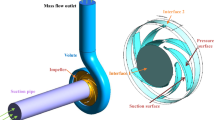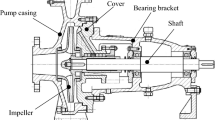Abstract
The article describes the possibilities of the numerical modelling of cavitating flow in high-performance pumps for power generation. Three main adverse effects of cavitation and their analysis are discussed with some practical examples. Numerical analysis is based both on the commercial CFD code and the inhouse software solving the Rayleigh-Plesset equation along flow trajectories. Cavitation bubbles at the same time are presented as active (not passive) impurity which interacts with fluid during the phase transitions.
Similar content being viewed by others
References
G. V. Tomarov, A. A. Shipkov, and T. N. Golubeva, “Criterion-parametric prediction of cavitation erosion of metal for components of the condensate-feed channel of nuclear power plant power units,” Therm. Eng. 59(4), 325–331 (2012).
Y. Tsujimoto, “Cavitation instabilities in inducers,” in Design and Analysis of High Speed Pumps. Educational Notes RTO-EN-AVT-143, 2006, Paper 8, pp. 8-1–8-26.
K. Kamijo, T. Shimura, and M. Watanabe, “An experimental investigation of cavitating inducer instability,” ASME Paper 77-WA/FW-14, 1977.
K. Yamamoto and Y. Tsujimoto, “Backflow vortex cavitation and its effects on cavitation instabilities,” Int. J. Fluid Mach. and Syst. 2(1), 40–54 (2009).
G. Berntsen, M. Kjeldsen, and R. Muller, “Cavitation induced dynamics in hydraulic machinery,” in Proceedings of the 10th IAHR WG Meeting on the Behavior of Hydraulic Machinery under Steady Oscillatory Conditions, 2001, pp. 1–8.
Y. A. Bouziad, Physical Modeling of Leading Edge Cavitation: Computational Methodologies and Application to Hydraulic Machinery, Thesis No. 3353 (Ecole Polytechniqie Federale de Lausanne, 2005).
Y. Tsujimoto, H. Horiguchi, and K. Yonezawa, “Cavitation instabilities in turbopump inducers. Analyses in 1–3 dimensions,” Int. J. Fluid Mach and Syst. 3(2), 170–180 (2010).
M. Sedlář, M. Bajorek, and J. Šoukal, “Investigation of cavitation phenomena in suction part of radial-flow pump,” in Proceedings of the 7th European Conference on Turbomachinery, 2007, pp. 785–794.
M. Sedlář, O. Šputa, and M. Komárek, “CFD analysis of cavitation phenomena in mixed-flow pump,” Int. J. Fluid Mach. and Syst. 5(1), 18–29 (2012).
M. Sedlář, F. Maršik, and P. Šafařik, “Modeling of cavitated flows in hydraulic machinery using viscous flow computation and bubble dynamics model,” in Proc. Fluid Dynamics, Prague, 2000, pp. 107–110.
P. Zima, M. Sedlář, and F. Maršik, “Bubble creation in water with dissolved gas: prediction of regions endangered by cavitation erosion,” in Water, Steam and Aqueous Solutions for Electric Power. Advances in Science and Technology (Maruzen Co., Ltd, Kyoto, 2005), pp. 232–235.
P. Zima, M. Sedlář, and M. Müller, “Modelling collapse aggressiveness of cavitation bubbles in hydromachinery,” in Proceedings of the 7th International Symposium on Cavitation, CAV 2009, Ann Arbor.
M. Sedlář, P. Zima, and M. Komárek, “Numerical prediction of erosive potential of unsteady cavitating flow around hydrofoil,” Appl. Mech., Mater. 565, 156–163 (2014).
M. Sedlář, M. Komárek, M. Vyroubal, and M. Müller, “Experimental and numerical analysis of cavitation flow around a hydrofoil,” EPJ Web of Conf. 25, 01084 (2012).
Author information
Authors and Affiliations
Corresponding author
Additional information
Published in Russian in Teploenergetika.
The article is published in the original.
Rights and permissions
About this article
Cite this article
Sedlář, M., Šoukal, J., Krátký, T. et al. Numerical prediction of impacts of cavitation in pumps for power generation. Therm. Eng. 62, 408–413 (2015). https://doi.org/10.1134/S0040601515060087
Published:
Issue Date:
DOI: https://doi.org/10.1134/S0040601515060087




